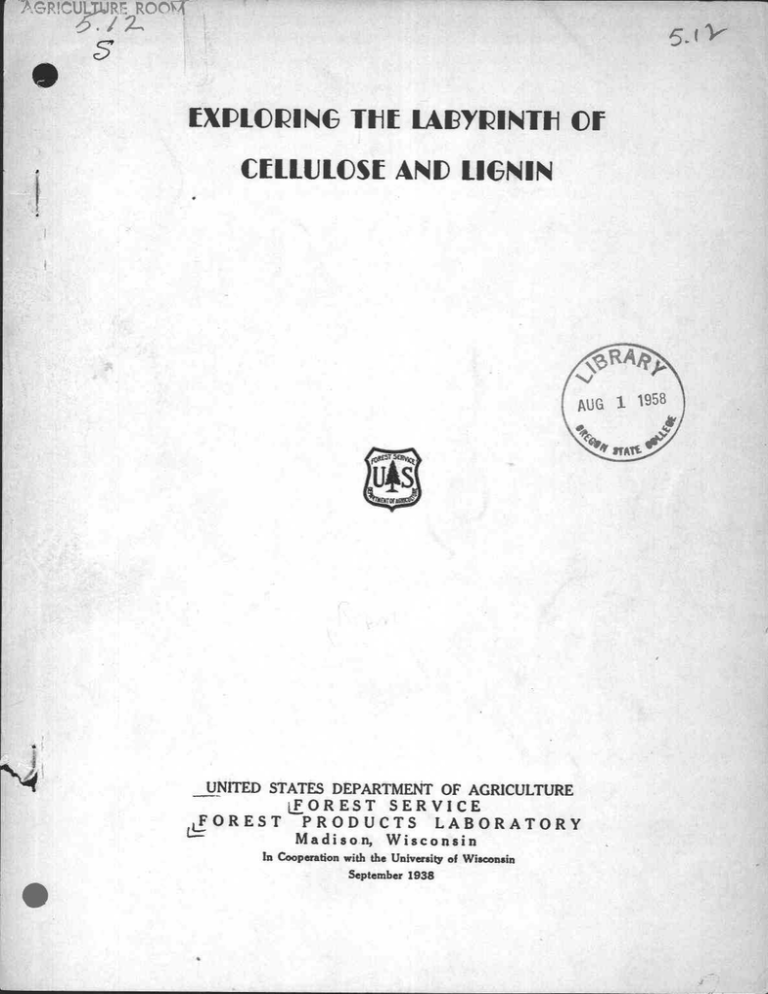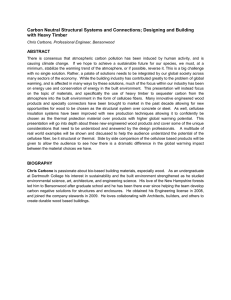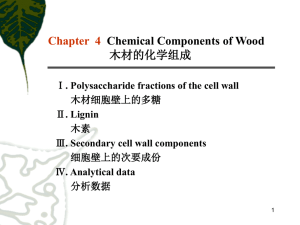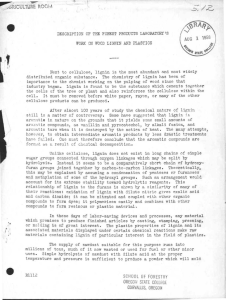EXPLORING TtiE LABYRINTH O F CELLULOSE AND LIGNIN 5- RF
advertisement

G R!CU RF ROCS ~! .12, 5EXPLORING TtiE LABYRINTH O F CELLULOSE AND LIGNIN UNITED STATES DEPARTMENT OF AGRICULTUR E FOREST SERVIC E FOREST PRODUCTS LABORATOR Y Madison, Wisconsi n In Cooperation with the University of Wisconsi n September 1938 EXPLORING THE LABYRINTH OF CELLULOSE ANL LIGNIN 1 By E . C . SHERRARD, Principal Chemis t Wood comes as a finished product of nature to the hand of th e builder and the craftsman . To the chemist, however, wood is no more a finished product than is a slab of coal or a field of flax . It is raw plant tissue of specialized type ; its true usefulness can be determine d only by a thorough discovery , of its inward structure and substance . I n the domain of physical and organic chemistry lie possibilities not onl y of converting wood into manifold new products of value, but also o f adapting it more and more adequately to requirements of established use . Wood is a definite entity ; it is substantially alike in tree s of all species . Its chemical make-up, however, is not simple . To say that it consists of the elements carbon, hydrogen, oxygen, and none othe r is a truth leading nowhere in particular ; the same analysis would hol d for sugar, carbolic acid, or pine rosin . Even to measure C, H, and 0 by quantitative methods reveals no property of wood except as a fuel . To far more subtle approach . capture its concealed values requires a Wood is a mixture . Experimentation a century ago accomplishe d its separation into two main components -- a fibrous, cotton-like par t comprising the cell bodies proper and designated as cellulose, and a par t denominated lignin, the essentially n woody n component, appearing chiefl y as an encrusting or compacting medium between the cells . There als o exist in wood, in some associative pattern, a considerable group o f intermediate compounds, designated in general as hemicelluloses . Furthermore, wood is a labyrinth . It consists of parts withi n parts . Methods of microchemistry, recently developed, have thrown ligh t on its inner recesses, The lignin complex has been isolated as a continuous web or honeycomb, with traces of interpenetration into the fibe r walls . The fiber, a hollow body of about the size of a hair removed i n shaving, has bean examined throughout its range of visible structure . About it is coiled a cellulose filament of marvelous fineness, bindin g its parts together . Within, it is found to consist of three or mor e concentric layers of cellulose, each a compact of some hundreds o f parallel-fibrils having a slight slope or twist about the fiber axis . Composing the fibrils are still smaller spindle-shaped integers, name d fusiform bodies . These, in turn, are made up of ultimate microscopi c objects, units of cellulose so minute that their relation to the whol e fiber is as a golf ball alongside the Washington monument . 1 - Published in the Journal of Forestry, 1 93 g , R11S9 11.36, No .9, pp .SS2- g 5, Septembe r S Taking up the search where the microscope must leave off, instrumentalities such as the ultracentrifuge and the X-ray are yieldin g information on the molecular dimensions and character of both cellulos e and lignin, Closely related studies are exploring the maze of capillar y and submicroscopic water-conducting passages throughout wood . Thei r fineness and manifold complexity are witnessed by the finding that , within a single cubic inch, the internal wood surface bounding them i s more than 50,000 square feet . The scientific concept thus obtained of the wood aggregate an d its subdivisions, though still far from complete, has bearings on presen t technical problems and far-reaching implications for the future . Fo r example, recognition that lignin forms an enveloping matrix about th e fibers led to the development of the "semichemical t" pulping process , the story of which, with its high yields and its successful adoptio n in industry, is told in another section . Structural analysis of th e cellulose fiber has made clear to the papermaker the degree to whic h fibrillation of a pulp, produced by beating, affects the strength o f paper . It has also, for the first time, given the rayon manufacture r a .know].edge of the various microscopic units through which the fibe r passes during dispersion of cellulose prior to its emergence throug h the spinnerette . In the drying of wood, successful results depend o n the proper removal of water from its minute structure by diffusio n after the larger cell interiors are empty . Increasing knowledge of the structure in which diffusion takes place aids in setting up efficien t drying conditions, either by temperature and humidity control or by th e new method of chemical seasoning elsewhere described . To the general user, the one greatest drawback to wood i n service has been its tendency to shrink or swell as its moisture environment changes . Successful antishrink treatments were unknown until, i n the course of research, it was realized that moisture-excluding agent s must be used which will bond with the innermost parts of the wood sub stance . By a new "substitution" method of impregnation with syntheti c resins, the swelling and shrinking of wood can now be reduced to abou t one-quarter of that naturally occurring . The process is applicable t o superior manufactured articles such as shoe lasts, athletic goods, brus h backs, lithograph blocking, and musical instruments, and studies are no w under way looking to its use in the production of a permanently weather proofed plywood for house construction . In these and related fields o f wood research -- preservative treatment, painting, gluing, decay investigations, and the rest -- the facts of woods minute structure supply the , necessary groundwork of both sound theory and improved processes . Cellulose fiber is the acknowledged treasure of the wood , labyrinth . For decades chemists have found its investigation excitin g and rewarding, until today the world stands fascinated with the profusio n of its products -- papers of every variety, boxes, cartons, and fanc y wrappings, rich fabrics, pressed and molded articles, photographic an d projection films, lacquers brilliant of hue and surface . To this grea t development the Forest Products Laboratory has contributed its part b y R1189 -2- clarifying ideas as to what constitutes the cellulose part of wood an d by devising means of recovering more of it in useful form . According to common analytical procedure, wood is considered . to contain about 6o percent of cellulose . A new concept, however, ha s arisen with the introduction of a less severe method, by which wood i s found to yield a total carbohydrate fraction of 77 percent, Signifyin g its cellulosic character, the carbohydrate component has been given th e name holocellulose . Not only does holocellulose contain substance s formerly disintegrated, but its content of superior fiber, the toug h alpha-cellulose of fine paper and rayon, is considerably higher tha n has been obtained before, either analytically or commercially . Thi s fact points to the possibility of new and radically different pulpin g processes, with higher yields and less waste . The setting up of the new body, holocellulose, has found a n incidental application outside the field of forest products . Researcher s in animal nutrition have wanted to find out to what extent lignin interfered with the assimilation of plant carbohydrates, but have never bee n able to remove the lignin without also removing part of the carbohydrates . Rolocellulose, the total carbohydrate group, lignin free, was the answe r to their problem . In the recovery of pulps with high yields, the so-called hemicelluloses will play a major or minor part, according to the degree o f refinement required in the final product . On the other hand, thei r purposes such as ethyl alcoho l part in hydrolytic reactions for production is exceedingly interesting, as many of them are readily convertible into sugars . While their structure and relationships in th e wood complex are not as yet fully determined, current studies indicat e the close association of at least a part of them with the ligni n fraction . The acetyl and certain of the methoxyl groups, however, whic h yield acetic acid and methyl alcohol, have been shown to be chemicall y attached to the cellulose . If cellulose is the treasure of wood, lignin as hitherto regarded has been mere slag or offscouring -- dross to be purged in th e winning of fiber ; and it pours out from pulp mills at the rate of a million and a half tons a year, to pollute rivers and perplex th e public and conservation authorities . Yet lignin, comprising one-quarte r of the wood substance, was put together by nature for a definite function . It must have definite chemical characteristics, and perhaps, were thes e fully known and determined, products might be developed from it as usefu l as those now extracted from packing-house wastes or from that once value less refuse, coal tar , Such was the conception with which the current research o n lignin was undertaken . The chemical problem has proved as hard as it s past history would lead one to expect . Lignin is a stubborn material , ambiguous in its reactions and grudging of any clues to its compositio n or hidden values ., A limited disposal of lignin-bearing pulping waste i s R11S9 -3- S t found in the manufacture of linoleum adhesive and in tanning operations , and its use as a road binder or a component of fertilizers offers som e promise ; but for lignin itself, the utilization program awaits a fulle r revelation of what it is . The unknown is at last taking shape, Paralleling the hole cellulose separation, lignin is now segregated as a thing in itsel f free of all cellulose-degradation products . Considerable difference s between typical hardwood and softwood have been distinguished . g iv e hydroxyl groups have been identified as a part of lignin, one of the m being a secondary alcohol and another an enolic compound that can con dense with phenols to form resins . Five methoxyl groups have likewis e been identified, one of which on distillation of wood yields methy l alcohol . Another finding, which departs radically from former conceptions, is the disclosure by X-rays that lignin has a definite crystal line structure ; all previous conclusions were that it was amorphous i n character . Research has lately been reinforced with the powerful aid o f the hydrogenation process, the transformation by which gasoline is generated from coal, and cooking fats from vegetable oils, Under hydrogenation, lignin can be converted completely into glycols, alcohols, an d a residue similar to a high-grade synthetic resin . One of the alcohol s produced is plopyl-cylohexanol, a liquid of pleasant odor suitable fo r use as a lacr_aer vehicle, It is also inhibitory to wood-destroyin g fungi and hence gives promise as a wood preservative . Of the two glycols , one is a waxy crystal and the other a viscous liquid adapted for use a s a thickening and toughening agent for varnish . These various developments are only parts of a chemical pictur e which remains to be completed . But they are already opening up vista s into an economic future for lignin . A fortunate outgrowth of the researc h has been a vast improvement in the performance of millions of automobil e batteries . No sooner had lignin been isolated in pure form than manufacturers began incorporating it as a part of negative battery plates , with a tenfold increase of current output in zero weather . I At an early stage of the lignin research it was noted tha t formaldehyde had a pronounced softening effect on the material, an d that upon drying a hard, resinous product was obtained . This observation led directly to the development of a process for the production o f a new type of molding compound . Its formation depends on the removal o f part of the cellulose from wood by cooking with dilute acid, with consequent increase of the lignin content of the residue . The softenin g point of the lignin is lowered by the addition of plasticizers such a s aniline and furfural, so that the mixture can be hot-pressed at 3,00 0 pounds per square inch to form a hard, dense, brilliant black molde d product of low cost . A number of industries are interested in it, an d its possibilities in the production of plastics from wood waste, especially sheet materials, panels, and wall boards, are very apparent . Rll g 9 -4- Such, in outline, is the account of the Laboratory's explora tion of the wood labyrinth to date . Pacts of scientific and practica l value are being brought to light, and the boundaries of the unknown ar e being pushed back a step at a time . The search goes hand in hand wit h efforts of other workers, and by this cooperative attack the time i s being hastened when the inner wealth of wood will be fully at the com mand of society, R1189 -5-




